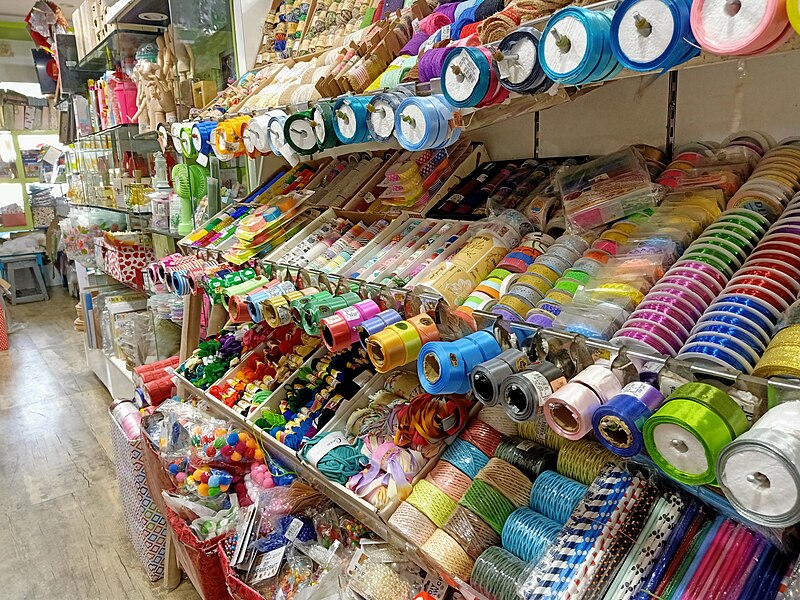
So we’ve already covered knitting and dressmaking – let’s explore some more ones to try! For all of these crafts, there are many ways to begin depending on your learning style – including video tutorials, books, craft kits, and even in-person classes if you’re lucky to have some nearby. Look at your local schools and colleges for adult evening classes, or see if your local craft stores or practitioners have groups or learning opportunities.
As well as a finished project, you’ll also find that it benefits both your manual dexterity and can be a great mindfulness activity.
Macramé

Macramé is is a yarn craft, like knitting and crochet, but it is produced by creating a series of knots. Once you’ve mastered the square (reef) knot and hitch combinations, you’ll be able to produce something. Macramé was started in the Middle East by embroidered who knotted the excess thread along the edges of towels, veils, and shawls in a decorative manner.
It was brought to the UK during the late 17th Century, but became most popular during the Victorian period as a decorative lace-like trim for both Homeware and clothing. It was also popular with sailors, who used rope to make knotted items like bottle covers and cosies. There was a surge in popularity in the 70s, when it was used to create wall hangings, tablecloths, and plant hangers, as well as combined with beads to make macramé jewellery.
Mosaic Art

Have you ever smashed a piece of crockery and thought it was a shame to get rid of the broken china? Why not give making a mosaic a go! Mosaics are images or patterns made from small pieces of coloured ceramic, glass, or stone – and held in place with plaster on a surface. Dating back to 3000 BCE, ancient mosaics have been found in the Middle East, Greece, and Rome, often depicting religious imagery.
Modern mosaics are made using many materials, both the traditional and even things like shells, coins, and charms – a great way to display treasures and memories from holidays. Hobbyist mosaic artists usually work on smaller and more portable surfaces, like photo frames, small tabletops, plant pots, etc.
Cross Stitch

Cross stitch is an embroidery technique made up of small X-shaped stitches to form an image. This craft dates back to the Middle Ages, with pieces on display in folk museums worldwide. Traditionally, young women learned to cross stitch by creating a Sampler, which also boasted that she could read the alphabet. Cross stitching was used as a decorative technique for household items like tablecloths, pillow cases, and handkerchiefs.
Nowadays, the cross stitch craft appeals to all genders, although women remain the highest proportion of stitchers. Contemporary designs feature modern sayings, tattoo design imagery, and some more risqué art. With modern technology, it is possible to find a design for anyone, ranging from cars and footballers, to seasonal designs, to TV shows and movies. There are also programs available to help you create your own design.
Pom Poms

Pom Poms are a really fun and easy craft to try for beginners or if you have low manual dexterity. Pom poms are traditionally used in clothing and accessories. They are most associated with headwear, usually seen on knitted hats. They also feature heavily in uniforms, from the French naval Bachi hat, to the Biretta hat worn by Roman Catholic priests. In Scotland, they are known as Toories, and appear in the centre of Tam o’Shanter hats in both Highland dress and military uniform.
Pom Pom making kits are widely available, and are a great way to use smaller quantities of yarn. They can be made in seasonal colours to make into decorations, strung together as a garland, hung singly on the tree as baubles, or assembled into a ring to make a fun wreath. As well as adding to hats as is tradition, they can be a fun addition to shoes and bags. There are also plenty of tutorials out there to make Pom Pom sheep, bees, fruit, and seasonal shapes like pumpkins and Christmas puddings. You can also experiment with materials, try using twine or string for a rustic look, or ribbon for a fun feminine vibe.
Pottery

Pottery is one of the most ancient crafts, dating back to the Stone Age. Early pottery was hand-shaped, and fired in a bonfire pit. Potters wheels were invented in the ancient Middle East, between 6000 and 4000 BCE. Whilst we might think our ancestors were using clay just to create rudimentary essential items like cookware and receptacles for food and drink, there is substantial evidence that they were making ceramic art statuettes like the Venus of Dolní Věstonice before 25000 BCE!
Whilst you might have to find a pottery class to try throwing a pot on a wheel, or firing your ceramics in a kiln, there are many kits available with air-dry clay or oven-bake clay. Whether you want to make clay figures, decorative items, or household items like flower pots or mugs – there’s so many different companies making kits for all levels and tastes – or if you think you’re ready to go it alone, find pottery supplies at your nearest arts and crafts shop or online.
Which craft can you not wait to try?
